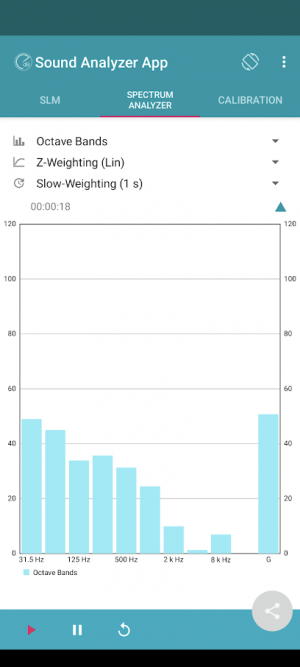- Joined
- Apr 23, 2018
- Messages
- 6,556
The app I've played with on Android is called Sound Analyzer. As long as the apps are built on NIOSH criteria or are meant to emulate an ANSI Type 2 SLM, they should be close enough. An actual Type 2 meter begins at $2500 (double it if you want a field calibrator, which is mandatory). I've used Type 1 meters that cost well over $10k. For perspective, a Type 2 is accurate to +/- 2 dB. If you understand that sound pressure energy is expressed in logarithms, even better. If you remember your log rules from calculus, then you might be able to apply some of the concepts. It's enough to know that you can't just add, subtract, multiply, or divide decibel numbers without converting back to pascals pressure, so don't go there. Just take the numbers at comparative face value.
To facilitate comparative analysis, I suggest you set up your sound level meters as follows:
1.) Set scale to dB(z). If (z) is not available, use dB(c). The two flat weighting networks are close enough, but dB(c) makes allowances for human attenuation at the extreme high and low end of the scales. Often it makes no (whole decibel) numeric difference, so we can ignore it here and accept (c) data into the set.
2.) Set meter to Slow response. We are measuring at steady state, so we want better stream equalizing. Fast and slow measurements are not comparable, cannot be normalized to each other, and do not belong together.
3.) Use the full octave band spectrum. This will show where high and low frequency noises come from, which indicate different drivetrain components. Like a good mechanic can tell the difference between a squeak and a hum, I can tell more from a spectrum than I can from a band average. There is no need for 1/3 octave band resolution here, full step center band octaves are good enough.
4.) The operator's position. Place the mic within a 24" virtual sphere representing the operator's ears. Do not take measurements inside of the cabinet unless the operator sits there while the machine is running.
5.) Stable reading. Obtain your reading at a steady level of noise, not random peaks. Eliminate unneeded background noise.
The studies I've read on these software SLMs using smartphones shows they're reasonably effective at +/- 3 dB. Should be close enough.
Screenshot showing full octave band, (z) scale attenuation, and slow meter response. If everyone does it this way, the experiment may be useful.

To facilitate comparative analysis, I suggest you set up your sound level meters as follows:
1.) Set scale to dB(z). If (z) is not available, use dB(c). The two flat weighting networks are close enough, but dB(c) makes allowances for human attenuation at the extreme high and low end of the scales. Often it makes no (whole decibel) numeric difference, so we can ignore it here and accept (c) data into the set.
2.) Set meter to Slow response. We are measuring at steady state, so we want better stream equalizing. Fast and slow measurements are not comparable, cannot be normalized to each other, and do not belong together.
3.) Use the full octave band spectrum. This will show where high and low frequency noises come from, which indicate different drivetrain components. Like a good mechanic can tell the difference between a squeak and a hum, I can tell more from a spectrum than I can from a band average. There is no need for 1/3 octave band resolution here, full step center band octaves are good enough.
4.) The operator's position. Place the mic within a 24" virtual sphere representing the operator's ears. Do not take measurements inside of the cabinet unless the operator sits there while the machine is running.
5.) Stable reading. Obtain your reading at a steady level of noise, not random peaks. Eliminate unneeded background noise.
The studies I've read on these software SLMs using smartphones shows they're reasonably effective at +/- 3 dB. Should be close enough.
Screenshot showing full octave band, (z) scale attenuation, and slow meter response. If everyone does it this way, the experiment may be useful.


